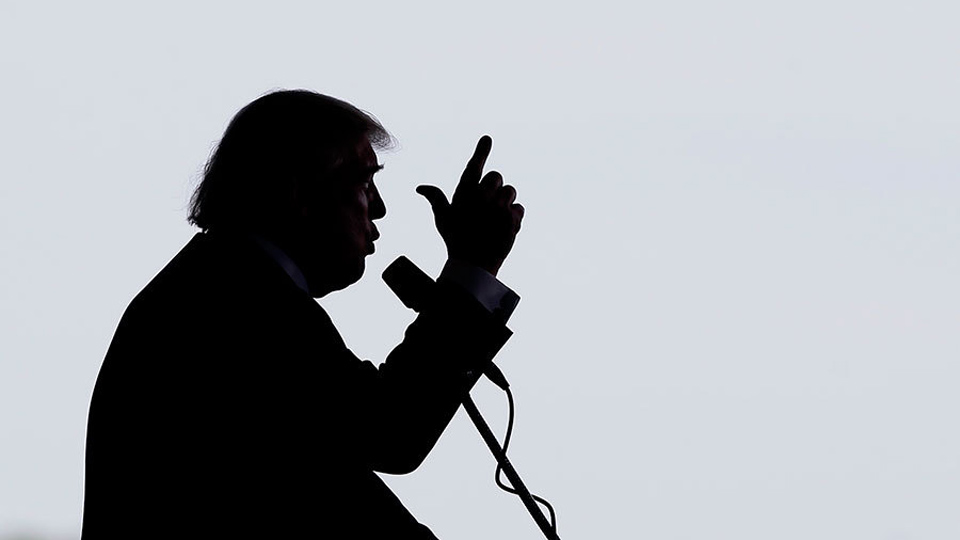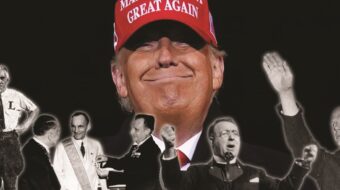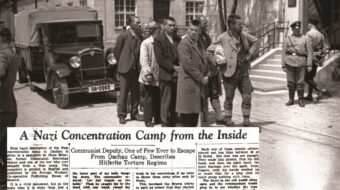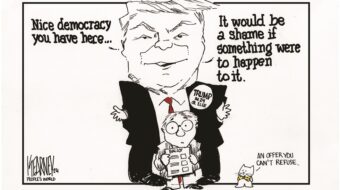
Donald Trump will become the fifth person in the 228-year history of the American presidency, and the second in the last 16 years, to gain office while running second in the popular vote.
This is because of the Electoral College, which has been attacked as an undemocratic anachronism since the election of 1876 but has been sustained because of the influence that it gives to state political organizations.
In other presidential systems throughout the world where there are representative elections, a runoff is held between the two top finishers if one candidate does not receive an outright majority, to guarantee a majority winner.
If those were the rules in place, Trump would in all probability lose a runoff election, in part because significant numbers of his own voters have mixed feelings about his election, having voted out of rage against corporate bailouts, de-industrialization, deepening inequality, and insecurity.
To be honest, many blamed government for this and not contemporary Robber Baron capitalists like Trump himself. Many have bought into the big lie that Big Government favors people of color and women — in employment, education, even access to social welfare benefits. The merger of these two themes, the first based on real long-term economic decline for all working people, the second on irrational and self-destructive scapegoating of foreigners and minorities, was and is the foundation of fascist mass politics.
The left should face the fact that the presidential election, in spite of its undemocratic though legal, constitutional character, is the most significant electoral victory for fascist mass politics since the end of the Second World War. As such we have the responsibility to rethink our tactics and our strategy if we are to work successfully to organize, educate, and coordinate the struggle against fascism.
Turnout and voter suppression
To begin with, the turnout was 57 percent of eligible voters, the lowest in 20 years. In key states, Wisconsin being the best example, “crosschecking” and photo ID rules kept tens of thousands of voters away from the polls. Even if the turnout were 70 percent of eligible voters, it would still fall below average for elections in countries with representative elections, although these averages have been dropping with the decline of trade unions and mass labor, socialist, and communist parties.
Even if one does not factor in voter suppression, Donald Trump lost the popular vote and will reach the presidency with around 25 percent of all eligible voters, including the third party vote. This means that Trump has a mandate for nothing, although he threatens to deport two to three million undocumented workers in the first months of his administration, without saying how this will be done nor where they will be deported to. That in itself is both unprecedented and a move in the direction toward a fascist police state.
What is fascism and how do the U.S. and Europe differ?
While Trump has used major themes from fascist mass politics in his campaign and has associated with contemporary neo-fascists, what are the dangers that his seizure of the presidency can result in a full-blown fascist regime?
Marxist-Leninists or communists defined fascism as it existed in the 1930s as the open terroristic dictatorship of the most reactionary sectors of the capitalist class in the service of finance capitalism.
Fascist parties in Germany and Italy, for example, railed against the Big Banks and the big merchants of the cities who were destroying local businesses, as Trump has done, but blamed this on Jewish international bankers in the Nazi case and on banking syndicates controlled by foreign powers in the Italian case. Here, Trump portrayed Clinton as the “evil and corrupt” tool of government and business forces, whom he as supreme leader (Führer in German, Duce in Italian) would magically defeat and drive from power.
Once in power, fascist parties destroyed existing trade unions, non-fascist political parties, and all mass democratic institutions, establishing state capitalist systems which directly served finance capital. German corporations profited directly from the Hitler dictatorship, as did U.S. firms like GM, Ford, Standard Oil, and IBM, which through their international subsidiaries gained huge profits as they helped to build Hitler’s military-industrial complex and exported oil to fascist Italy, Nazi Germany, and the Japanese Empire.
The Wall Street “boom” which has followed Trump’s victory should be evidence that U.S. and global finance capital, like their predecessors in the 1930s in Germany and elsewhere, realize that they are the ones who have the most to gain from a Trump government.
In power, Trump will attempt to pass national right-to-work legislation, block all efforts to raise the minimum wage, sharply decrease taxation on corporations, and less sharply on the wealthy. He has also pledged to repeal both the Dodd-Frank Wall Street Reform and Consumer Protection Act, which will give more “freedom” to Wall Street and finance capital generally, and the Affordable Care Act (“Obamacare”), along with Obama administration restrictions on the cost of medical prescriptions. His contempt for civil liberties and civil rights and admiration for what students of fascism call a pseudo-masculine cult of violence — that is, beating, arresting, torturing, and killing political enemies — are matters of record.
The European countries which fell to fascism had multi-party systems, sometimes involving coalition governments. The first Mussolini and Hitler governments were “constitutional,” in that conservative governments gave power to Mussolini in 1922 and Hitler in 1933 in response to both terroristic street violence of the fascist parties and self-destructive divisions among their socialist and communist opponents, and in the German case the escalating depression and the fear among the German ruling class of an imminent communist revolution.
In the U.S., Trump, a real estate/hotel/casino magnate, television personality, and “brand name” purveyor of vodka, beefsteaks, video games, clothing, and an Internet-based “University,” among other things, is a kind of living textbook example of the decay of the U.S. economy, politics, and popular culture. He entered the Republican presidential contest although in reality he had never been clearly a Republican, and gained the nomination by nihilistic “shock politics,” insults and name-calling having nothing to do with issues, falsehoods that were easily fact-checked, and outlandish statements on subjects he knew little about. His egotistical ranting is continuing after his election.
In the aftermath of Hitler’s victory in Germany, communists and socialists began to form united fronts, first in France in 1934 to prevent French fascists inspired by Hitler’s victory from seizing power. Then, starting in 1935, the third or Communist International (Comintern) took the lead forming broader people’s (popular) front coalitions around the world to prevent new fascist victories and aiding anti-fascist forces in nations under fascist control.
The people’s front alliances of the 1930s, as C.J. Atkins noted in the People’s World after the Nov. 8th election, constitute the best model that we have to fight fascism. They were successful in preventing fascists from taking power in many countries in the 1930s, even though they failed to implement collective security alliances able to prevent fascist military aggression and eventual world war.
In the U.S., Trump has gained the presidency, meaning that new variations on the people’s front strategy will be necessary.
Possible new variations
The first is to realize that the trade unions, the civil rights and civil liberties organizations, and the Democratic Party, with all of its contradictions, represent the first line of both defense and counterattack against the fascist danger. There are already important developments in this regard.
Bernie Sanders’ Our Revolution mass organization has committed itself to supporting Keith Ellison as the new Democratic National Committee chair. In many states, militant progressive Democrats won elections, and various rightist initiatives were defeated. Developing active opposition to Trump and his supporters at the local and state level and challenging Republican apologists for Trump’s administration from its very beginning is the only realistic anti-fascist strategy in the U.S.
In this regard, we have the model of the pre-Civil War abolitionists who, facing pro-slavery presidents and monstrous legislation like the Fugitive Slave law, resisted such legislation at the state and local level. They invoked the states’ rights doctrines used by the slaveholders and their allies against them, and later won major political victories by organizing against rather than merely criticizing the Kansas-Nebraska Act, which expanded slavery into the Western territories. They actively opposed the Supreme Court’s 1857 Dred Scott decision, which potentially made slavery the law of the land and deprived of their citizenship even free people of color.
Today, opposition to the Trump presidency is centered in the large cities, where Democratic mayors and city councils are in power and where the electorate voted heavily against Trump. An effective People’s Front policy begins in American cities nationwide.
From the abolitionist-led campaigns a new party, the Republican Party, emerged out of the Whig Party, which had compromised with the slaveholders through the entire antebellum period until it collapsed of its own contradictions. At present, grassroots movements are focusing on turning the Democratic Party into a “new party,” one that will revive under contemporary conditions its New Deal and Great Society heritage and lead rather than block people’s movements.
Today the term “rustbelt” — the de-industrialized non-metropolitan areas of central and western Pennsylvania, West Virginia, Michigan, Ohio, northern Indiana and Wisconsin, where the Clinton vote dropped sharply compared to the Obama vote, giving Trump his victory in the Electoral College — is being revived.
These are areas where Tea Party Republicans won victories in 2010, building upon deep resentments over the Obama administration’s failure to come forward with a jobs program while it spent hundreds of billions to bail out monopolistic banks, brokerage houses, and industrial corporations that were “too big to fail.”
Winning back these regions requires mobilizing working-class voters to act in their own class interests rather than withdraw from the political process and focus their anger on traditional scapegoats. Those voters can be compared to poor whites in the post-Reconstruction era who focused their anger on disenfranchised Blacks who were poorer than they were, but now it’s undocumented immigrants without civil rights who are also poorer than they are.
A new Democratic Party must develop the capacity to go into these counties and organize opposition, bringing out new voters who can defeat the Republican right at all levels.
This is an outline for a new People’s Front, which is being discussed right now by those forces who supported Bernie Sanders for president and hold up Sanders and Elizabeth Warren as the most important leaders of a new Democratic Party.
To bring back the words of Franklin D. Roosevelt during the Depression, what is needed first is “action and action.” Then, during the call for sacrifice in WWII, he called upon us saying, “It can be done because it must be done.” This is the challenge that we face today.












Comments